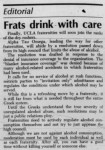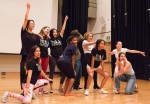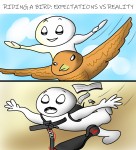Throwback Thursdays are our chance to reflect on past events on or near campus and relate them to the present day. Each week, we showcase and analyze an old article from the Daily Bruin archives in an effort to chronicle the campus’ history.
The consequences of alcohol misuse have long loomed over UCLA fraternities – long before the new regulations on alcohol consumption were put in place last September.
In fact, it’s been happening for more than 30 years.
In February 1986, after it was denied insurance coverage because of too many alcohol-related incidents, the Alpha Tau Omega fraternity joined what was then called “the ranks of dry rushers,” according to a Daily Bruin article published at the time. The resolution, drafted by what was then referred to as the “high council,” demanded the fraternity discontinue alcohol service at rush events, as well as regulate alcohol consumption at parties and limit admission to the parties to invitation only.
Thirty-two years later, and it seems we are still fighting the same battles.
While fraternities originated in the U.S. in the late 1700s as secret societies that discussed social, political and literary theory that was barred from academic curriculum, alcohol misuse is now as deeply embedded into the culture as intellectual discussion used to be.
Two months ago, the North-American Interfraternity Conference gave UCLA fraternities until Sept. 1, 2019 to ban all drinks with an alcohol content of more than 15 percent. The council made the decision after two alcohol-related deaths occurred at fraternities in the organization. Its resolution included nothing about the nature of party invitations, even though a limit on who can attend the parties has always been a fixture in fraternity culture.
Any female party-goer can attest to the disproportionate ratio between the sexes. While there are no formal invitations to fraternity parties anymore, it goes without saying that unless you are female or have some sort of connection to the fraternity, it can be difficult to gain entry to these events.
And, unfortunately there seems to be a growing association with Greek life and sexual harrassment.
The resolutions of 1986 and 2018 intended to prevent precisely such incidents, as well as alcohol-related deaths. The nature of these accidents may differ from year to year, but their ubiquity has sadly withstood the ravages of time.
The 1986 ban contended “fraternities need to actively regulate alcohol consumption themselves.” That advice clearly wasn’t taken to heart.
“Until the Greeks understand the true severity of unregulated alcohol abuse, such resolutions may be just a public relations ploy,” the Daily Bruin’s then-Editorial Board wrote.
The same holds true today – if this resolution is only successful in diminishing public concern about alcohol misuse, then there may be no point in pursuing it. Just in January, the Daily Bruin Editorial Board expressed its concern about student safety at parties and suggested fraternities should institute an indefinite alcohol ban.
The fact that a subsequent, more overarching ban was necessary just 32 years later goes to show internal regulation might not be the most effective method. Still, the 2018 resolution asks NIC-member fraternities to be responsible for enforcing the ban.
Only time will tell whether all party organizers will abide by the ban. In the meantime, we at least know UCLA fraternities are taking strides toward doing what the then-editorial board wrote “is needed throughout the entire Greek system:” reform.






